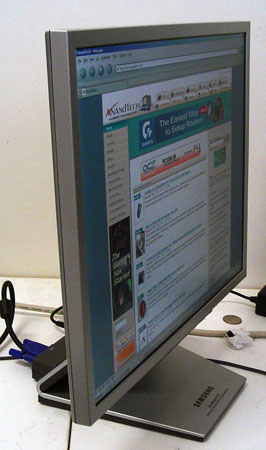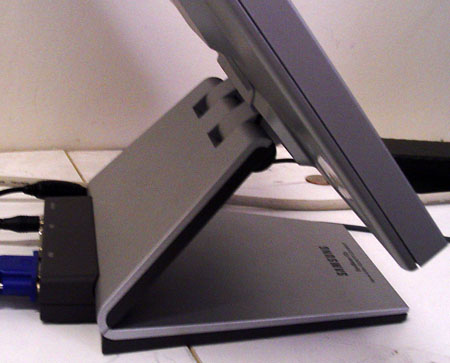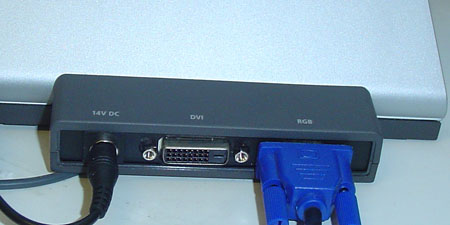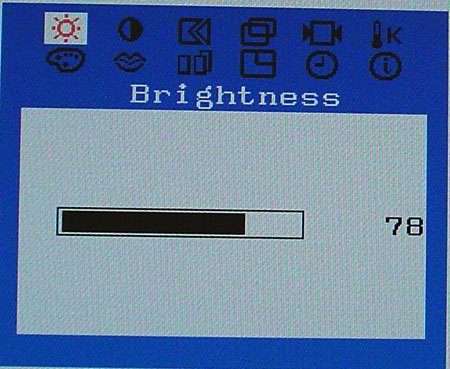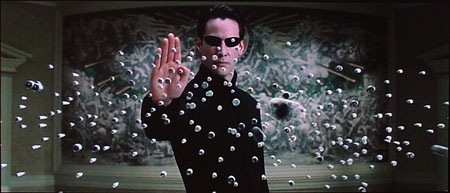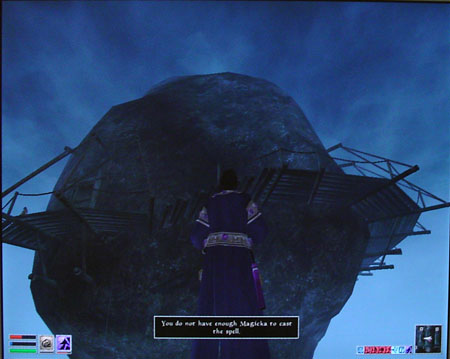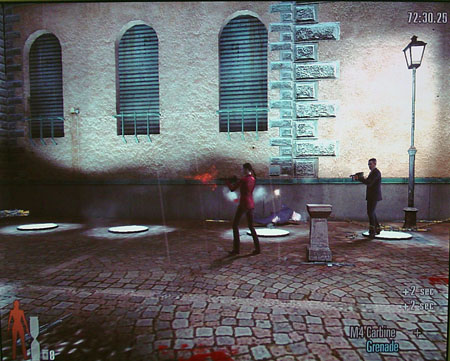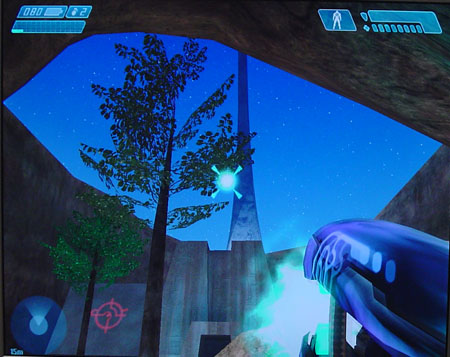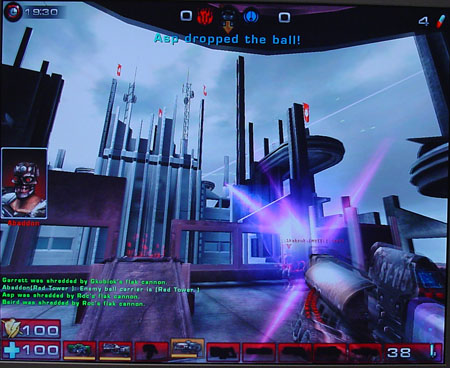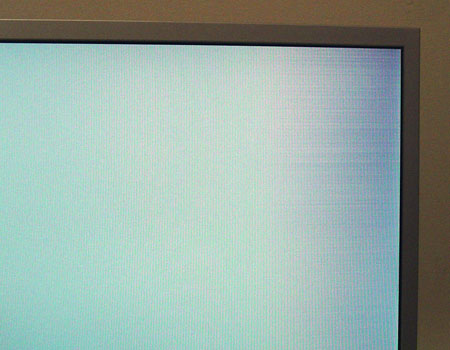
Original Link: https://www.anandtech.com/show/1342
Samsung 172X: 12ms Response Time for 17" LCD
by Kristopher Kubicki on June 8, 2004 12:05 AM EST- Posted in
- Displays
Introduction
Last week, we published our first 16ms, 19" LCD from Sharp with some interesting results. Even though the monitor performed great for gaming, there was a severe deficiency in some of the color replication due to the 6-bit LCD panel (instead of a typical 8-bit panel). Today, Samsung attempts a similar plunge into low response time LCDs with a 6-bit panel of its own.Construction
Most Samsung LCDs that we have seen in the past two years are radically different in design than anything else currently available. We expected the SyncMaster 172X to look like nothing else available right now.| Samsung SyncMaster 172X | |
| LCD | 17" SXGA LCD (Active Matrix) pixel pitch: 0.264mm Anti-glare coating TN Display Mode |
| Scanning Frequency | Horizontal: 30-80kHz Vertical: 56-75Hz |
| Response Time | 12ms (Typical) |
| Contrast Ratio | 500:1 (Typical) |
| Compatibility | 1280 x 1024 (Native) |
| Brightness | 270 cd/m2 |
| Power | Working: 40W Standby/Off: 5W |
| Warranty | 3 years parts and labor |
Unlike the Sharp LL-191A-B unit that we looked at last month, the Samsung 172X sports an even lower average response time - 12ms. Don't forget to check out our comments on response time in that publication. Unfortunately, the display uses a method of Frame Relay Control (FRC) on a TN mode display. Over the last few years, Samsung has relied almost exclusively on its own PVA (Pattern Vertical Alignment) display mode (a little bit more info is here). Going from PVA to TN display modes is a fairly big deal for Samsung; PVA is typically regarded as a much more elegant and efficient display mode. TN displays typically have shallower viewing angles and do not appear as crisp.
Specifications are fairly on par with what we have seen concerning other 17" LCDs from Samsung. Our 172X is slightly brighter than last year's SyncMaster 172T model; 270 nits versus 250. While correct, we could increase the brightness to surpass the luminance of some of our other 250 nit LCDs, and color washes out very quickly. This is tell-tale of the 6-bit LCD panel (we saw similar results on our LL-191A and Hitachi CML174).
Like many of our LCDs of late, the Samsung 172X had zero pixel defects. We did not find a single stuck pixel or subpixel.
Wallmont, Swivel, Pivot, Sound & Cable Management
Similar to the SyncMaster 192T and the SyncMaster 172T before it, the SyncMaster 172X uses a system of cable management found exclusively on Samsung LCDs right now. Rather than attaching power and input to the rear of the LCD panel, the 172X interfaces through the base of the monitor. This is still the most elegant cable management solution that we have seen to date.Also like the 192T, the 172X uses a double-hinged design. Essentially, the monitor has two folding axes; it can be adjusted along the x-axis twice. This allows us to change the vertical height and tilt of the monitor. Samsung's implementation of this double hinge is slightly different than what we saw on the SyncMaster 193P. We had some problems locking the 193P panel in place, but we do not seem to have the same issues with the 172X.
VESA wallmounts have shown up on every Samsung LCD that we can recall, and the SyncMaster 172X is no exception. Like the SyncMaster 172T, folding the monitor into a completely horizontal position and then affixing a mounting plate converts the monitor into a VESA ready unit without any screws. Unfortunately, in this position, the inputs will rest on top of the LCD instead of running down the bottom.
The monitor does not swivel or pivot along the y-axis or z-axis.
Samsung LTM170EX
The cornerstone of any good LCD monitor is the panel. Samsung's 172X is no exception. We have talked about different display modes and LCD panels in the past. Today, we want to talk about a display mode that is traditionally different from Samsung's PVA (Pattern Vertical Alignment) display mode. We will talk about TN or twisted nematic mode.If you have read our LCD primer, you may already be familiar with Twisted Nematic display modes, or other variations on TN, such as TN with some sort of Frame Rate Control. Sharp's LL-191A LCD uses a TN display mode, and we also explained that in the review.
In a nutshell, the problem with current LCD displays is that many of them cannot break the 25ms response time barrier. Response time has quickly become the most important specification when buying an LCD. In most cases, we call the "average" response time the time it takes a pixel to twist and untwist, also known as "time rising, time falling" (we abbreviate that as "TrTf"). As manufacturers approach the boundary of display technologies such as PVA, MVA and IPS, it appears the industry has come full circle; back to the original TN technology used in some of the first LCDs.
Here is the problem: as manufacturers continue to stretch the limitations of their slightly different twisting methods, they begin to hit the theoretical limit for how fast their twisting technology can work. Granted, each technology has advantages and disadvantages, particularly in the realm of viewing angle and color replication. Within the last year, however, AUO, LG Philips LCD, and now Samsung have all readopted the TN technology with some minor tweaks.
Just like the Hitachi CML174 and the Sharp LL-191A, the Samsung 172X uses a 6-bit LCD panel. Our particular SyncMaster 172X uses the Samsung LTM170EX, one of Samsung's newest panels not even listed directly on the website. You can find out more information through a Samsung Semiconductor brochure. Notice that the monitor claims 16.2M color replication - a 6-bit LCD with a dithering technology. In reality, this LCD can only produce 262,000 color shades, but by using a method of frame rate control, the panel controller can adjust voltages to emulate out of bound gray scales.
Aside from the 6-bit display, most things concerning the LTM170EX are quite outstanding. The 500:1 contrast ratio seems about right for a TN based display. Our monitor produces 270 cd/m2 brightness; although, we suspect the European version may actually produce 300cd/m2. Last, but not least, the response time claims an impressive sub-13ms response time. There is a small footnote stating that these results are measured at 25 degrees Celsius (77 degrees Fahrenheit). We suspect that the transition periods may be higher at lower temperatures, since the liquid crystals are at a slightly higher state of solidity.
On Screen Display
Samsung happens to have On Screen Displays with which we are familiar. Our 8th look at a Samsung LCD brings us to another revision of the same menu found on the SyncMaster 213T and 192T, but with a different button interface.Although the menu interface was on par with other Samsung user interfaces, the buttons were not as intuitive or clearly defined. From left to right, our buttons are labeled: Auto Sync, Exit, Menu, Power, Negative and Positive, and MagicBright. Since the buttons are located under the panel, instead of on it, we found ourselves fumbling the buttons a little too much.
Another interesting feature included in the 172X is the "MagicBright" feature, which we first saw in the SyncMaster 192T. This feature is implemented again exactly the same on the 172X. Depressing the MagicBright button gave us three levels of brightness presets, plus one custom user preset. We used the "Entertainment" preset for the remainder of the analysis.
Even though LCD technology has progressed faster than interface technology, we have always had the analog interface to fall back on. Fortunately, our 172X supports DVI and analog inputs. Switching between the two inputs can be done by pressing the "Exit" button.
Auto Syncronization has always been relatively hit or miss, even on high end LCDs. Much to our expectation, the SyncMaster 172X performs just about average concerning analog sync. A typical sync takes about 5 seconds and adjustment is only hit or miss. Several other LCDs that we have reviewed in the past occasionally adjust incorrectly on the first try, but on a second or third try, we are able to get the adjust to sync correctly. This does not seem to be the case with the 172X; if the Auto Sync does not adjust correctly on the first try, do not count on it working the second time. Horizontal alignment, color and brightness all worked very well, but vertical alignment was fairly inaccurate. Attempting to sync the monitor with black edges near the top of the screen will crop the monitor inaccurately, but will not stretch the signal height. If you adjust your monitor while running in some kind of console or command mode (white text on black background), expect poor or inaccurate results.
ColorVision Spyder
Before running DisplayMate and our subjective analysis of the LCD, we ran ColorVision's Spyder and OptiCal software. Not only does this calibrate the monitor accurately on the DVI and analog interface, but it also gives us specific luminescence information not obtainable through subjective analysis. Special thanks to our friends at Color Vision for providing us with both a ColorVision Spyder and their OptiCal software.Our test bed uses a Radeon 9800 XT video card. We use the factory included DVI cable for this portion of the benchmark. Resolutions are on the native 1280x1024.
Just like our last ColorVision benchmark, we have a few expectations:
- Other Samsung LCDs typically have a slightly more powerful red curve. This may or may not be the case with this LCD, since it does not use a typical PVA mode.
- Colors appear very good, but wash out relatively easily when the monitor is adjusted too bright.
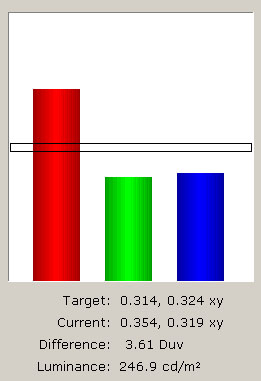
It seems as though Samsung uses the same technology to calibrate all of its LCDs, even the TN based models. Our results were very similar to other Samsung displays reviewed in the past. Brightness was noted as brighter than the other Samsung LCDs, which claim to have a 250 nit specification.
Using the OptiCal software, we were able to calibrate the SyncMaster 172X for the rest of the analysis.
Full Screen Application
Here are a few quick looks at some demanding full screen applications. All of these screenshots are taken with the Analog input on the LCDs.The Matrix Reload, The Matrix - The Matrix has several qualities to make it a good candidate for testing full motion video (color reproduction is not one of them). We are able to study image clarity and motion using a few of the same clips, and we were not disappointed with the 172X. Motion video was crisp, bright and vibrant. Adjusting the brightness too high would wash out the image, similar to the LL-191A.
Morrowind - Although Morrowind plays smoothly, some colors do not look just right. We noticed blue hues often when we should see grey ones. This may be due to over-correction in the calibration.
Max Payne 2 - Max Payne has been our standard test for light and dark comparisons as far as we can remember. While testing, we noticed an improved TrTf average response time compared to the SyncMaster 172T. Unfortunately, explosions looked a bit washed out; this seems to be a side effect of the 6-bit LCD panel.
Halo - We were fairly impressed with Halo's performance. Colors were very accurate after calibration, and as expected, we did not see much motion blur. The difference between the Sharp 191A and the Samsung 172X was negligible, but the difference between the Samsung 172T and the Samsung 172X was very noticeable.
Unreal Tournament 2004 - If we thought Halo looked good, Unreal Tournament was just icing on the cake. UT2K4 is a little more faster-paced than Halo, and the effect of motion blur is often detectable. Performance between the Dell 2001FP and the SyncMaster 172X were about the same. We were very pleased with the results.
Subjective Analysis
| DisplayMate/CheckScreen/VESA FPDM 2.0 | ||
| Test | Monitor | Observations |
| Intensity range check | 172X (digital) | 5, Good |
| 172X (analog) | 5 | |
| 2001FP (digital) | 5 | |
| 2001FP (analog) | 5, Good | |
| Black level adjustment | 172X (digital) | 4.5 |
| 172X (analog) | 4.5 | |
| 2001FP (digital) | 4.5 | |
| 2001FP (analog) | 4.5, Acceptable | |
| Defocusing, blooming and halos check | 172X (digital) | 5, None |
| 172X (analog) | 5 | |
| 2001FP (digital) | 5, None | |
| 2001FP (analog) | 5, None | |
| Screen uniformity and color purity | 172X (digital) | 5, Excellent |
| 172X (analog) | 5 | |
| 2001FP (digital) | 4.5+ | |
| 2001FP (analog) | 4.5+, better than 192T, but still small imperfection on upper right | |
| Dark screen (Glare Test) | 172X (digital) | 4, Similar to Samsung 192T |
| 172X (analog) | 4 | |
| 2001FP (digital) | 4.5 | |
| 2001FP (analog) | 4.5, Improvement over 1702FP and 192T | |
| Primary colors | 172X (digital) | 4.5 |
| 172X (analog) | 4.5 | |
| 2001FP (digital) | 4 | |
| 2001FP (analog) | 4, attempted to fix curves with OptiCal | |
| Color Scales | 172X (digital) | 4.5 |
| 172X (analog) | 4.5 | |
| 2001FP (digital) | 4, red errors | |
| 2001FP (analog) | 4, red errors | |
| 16 intensity levels | 172X (digital) | 5, Excellent |
| 172X (analog) | 5 | |
| 2001FP (digital) | 4.5+ | |
| 2001FP (analog) | 4.5+, Improvement over the 192T | |
| Screen regulation | 172X (digital) | 5 |
| 172X (analog) | 4.5, Imperfections along edges | |
| 2001FP (digital) | 5 | |
| 2001FP (analog) | 4.5 | |
| Streaking and ghosting | 172X (digital) | 5, none |
| 172X (analog) | 3, Intense streaking on simple images | |
| 2001FP (digital) | 5, None | |
| 2001FP (analog) | 3.5, Extremely present at 1600x1200. Analog signal is not capable. | |
Our first surprise came when we noticed how poorly the 172X held the analog signal. Any imperfections from the analog signal seemed only amplified by the TN display. Below is a streaking artifact generated by a simple alternating white/black column test pattern (Moire Column Pattern). The effect looks like a viewing angle imperfection in the still image, but careful analysis shows the streaking occurs no matter what viewing angle. The streaking only appears on the left and right sides of the screen, not the middle.
The monitor had particular issues with non-solid half tones. We suspect that this is related to the FRC dithering.
Using the Entertainment display mode in MagicBright, we achieved excellent intensity range and primary color tests. After correcting the image with OptiCal in the first half of this review, there were few instances where the color depth was unacceptable. However, we are capable of noticing the FRC enabled LCD versus a native 16.7M color panel; occasionally, the dithering creates patches of interference where the dithering should occur. This appears most frequently on the analog input, but is also present on the digital input. Fortunately, most people should be unable to detect these imperfections.
Final Thoughts
When we first received our Samsung 172X, we were fairly skeptical about its performance. Reviews across the web have been more or less mixed, some claiming the SyncMaster 172X is a prodigal monitor, while others claim just the opposite. In many cases, it appears to be a bit of both.Certainly, the step backwards in display panels, going from 8-bit PVA displays to 6-bit TN LCDs is not a great marker of progress. We found imperfections with the color rendition, which were better than our Sharp LL-191A. Unfortunately, some were not better than our Dell 2001FP or Samsung 192T.
On the other hand, the lower response time is definitely a step in the right direction. Looking back at our Samsung 172X, we could say that we were generally pleased and surprised. The US retail version of the LCD produces phenomenally better results than the Hitachi CML174. If you are convinced that response time is the final factor holding you back from getting an LCD, you may be fairly surprised with the 172X. Kudos to Samsung for producing the first 17" 12ms LCD, and doing an excellent job with it.
The SyncMaster 172X boasts the lowest response times to date, but even 12ms response times are not the end of the line. After working closely with Samsung over the last few weeks, we began hearing information about their next generation PVA enhancement - DCC-II. Samsung's DCC (and LG Philips' ODC) technologies both work by using algorithms to anticipate twisting the substrate (this is called "pre-tilt"). According to sources at the recent Society for Information Displays in Seattle, Samsung believes that the new DDC-II technology is capable of achieving 8ms gray-to-gray response times! Stay tuned for more LCD reviews at it appears things are just starting to heat up.

